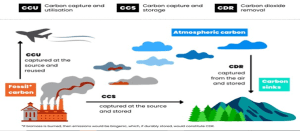NEW DELHI DECLARATION (GPAI SUMMIT)
TAG: GS 3: SCIENCE AND TECHNOLOGY
THE CONTEXT: The Global Partnership on Artificial Intelligence (GPAI) Summit held in New Delhi has concluded with the adoption of the ‘New Delhi Declaration. It reflected the commitment of 28 countries and the European Union to principles that align with democratic values and human rights in the development, and use of artificial intelligence. India hosted the annual GPAI Summit for the first time.
EXPLANATION:
- This declaration reflects a recognition of the importance of ethical considerations and accountability in AI technologies.
- This indicates a focus on ensuring that AI technologies are developed and deployed in a manner that considers long-term implications and societal well-being.
Commitment to democratic values and human rights
- The GPAI aims to be an inclusive movement, involving countries from the Global South and ensuring that the benefits of AI are accessible worldwide, aligning with the goal of global collaboration.
- The participating countries acknowledge and commit to addressing various challenges associated with AI, including concerns about misinformation, lack of transparency, fairness, protection of intellectual property and personal data, and potential threats to human rights and democratic values.
Innovation in Agriculture
- The declaration specifically recognizes India’s contribution to making agriculture a thematic priority for
- This reflects a recognition of the potential of AI innovation in supporting sustainable agriculture.
International Cooperation
- The summit emphasizes the importance of international cooperation to find the best possible solutions for the deployment and governance of AI.
- There is an expressed desire for GPAI to be more inclusive, encouraging the participation of developing countries as well as inclusion of lower and middle-income countries.
MEANING OF ARTIFICIAL INTELLIGENCE GOVERNANCE
Set of policies, regulations, ethical frameworks, and practices that guide the development, deployment, and use of artificial intelligence (AI) technologies.
Ethical and Responsible AI Development
- AI governance frameworks aim to establish ethical guidelines for the development of AI technologies.
Risk Mitigation
- Mitigating risks associated with AI technologies like risks related to data privacy, security, unintended consequences, and potential negative impacts on individuals and society.
Transparency and Accountability
- Transparent AI models are easier to understand, audit, and interpret.
- An accountable AI governance framework addresses issues of liability in cases where AI systems cause harm or make incorrect decisions.
Inclusive Decision-Making
- It involves involving diverse stakeholders, including experts, policymakers, industry representatives, and members of the public, to ensure a broad range of perspectives and avoid concentration of power.
GLOBAL AI FRAMEWORK CHALLENGES
Dynamic Nature of AI Technology
- AI is a rapidly evolving field, and staying updated with the technological advancements is a constant challenge for regulators and policymakers.
- Ensuring that regulations remain relevant and adaptable to new developments is essential.
Skills Gap and low public awareness
- There is a shortage of professionals with the necessary expertise in AI governance, policy-making, and ethical considerations.
- Building public awareness and engagement regarding AI technologies, their implications, and the potential risks is critical.
GLOBAL PARTNERSHIP ON ARTIFICIAL INTELLIGENCE (GPAI)
About the Initiative
- It is an international initiative established to guide the responsible development and use of artificial intelligence (AI).
- It aims to bridge the gap between theory and practice on AI by supporting cutting-edge research and applied activities on AI-related priorities.
- GPAI secretariat is hosted by the Organisation for Economic Co-operation and Development (OECD). It has 28 countries, including India, and the European Union as members.
History
- The partnership was first proposed by Canada and France at the 2018 G7 summit, and officially launched in June 2020.
- India is a founding member of GPAI, but the group does not include India.
CONCLUSION
- Members of GPAI agreed on the ‘New Delhi Declaration,’ showing a global commitment to using Artificial Intelligence (AI) responsibly, in line with democratic values and human rights.
- The summit highlighted the importance of an inclusive approach, welcoming participation from developing nations and ensuring that the benefits of AI are accessible to people worldwide.
- The declaration aims to address concerns related to AI, such as misinformation, transparency, and the protection of intellectual property and personal data.
